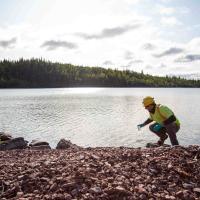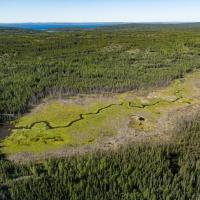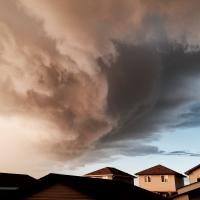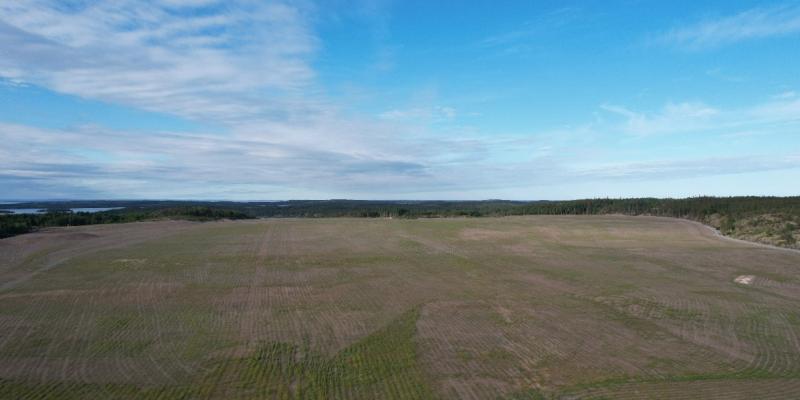Ecological Restoration and Revegetation
Revegetation is a critical component of industrial and government projects, such as infrastructure construction, contaminated site remediation, recreational area development and ecosystem restoration. Although there are standard practices and techniques for promoting plant growth, they may not address stakeholder expectations. Improper planning and implementation of site revegetation can result in unnecessarily high costs, compromised site stability and stakeholder frustration.
Regevetation planning should include:
- Consulting with project stakeholders (e.g., regulators, engineers and local communities) to clarify expectations and to identify the most-valued species for the novel ecosystem services
- Selecting native plant species to facilitate ecosystem recovery
- Identifying practical and effective revegetation techniques and implementation
- Monitoring criteria to assess the ecosystem recovery success
- Contingency planning to account for potential pitfalls and unexpected events
SRC has many years’ experience applying adaptive management strategies to revegetation planning and ensuring ecosystem recovery success under different conditions and budgets. We can help industry and governments achieve their environmental goals by helping recover damaged ecosystems through proper revegetation planning and implementation.
Specialized Expertise
SRC has decades of experience developing the science behind, and optimal application of, revegetation methods. Our remediation experts also have practical experience implementing these solutions as part of SRC’s multi-year, multimillion-dollar remediation project that includes 37 abandoned mine sites in northern Saskatchewan.
Our knowledge and experience benefit any land reclamation or restoration project. Our experts can help identify possible ways to reduce costs and ensure stakeholder satisfaction, particularly with communities and regulators.
We have world-class expertise in environmental management, plant ecology, agroforestry and soil science, as well as experience planning and implementing revegetation projects, which is essential for land reclamation and restoration work. Our specific expertise includes:
- Applied revegetation research
- Soil conditioning and bioremediation
- Native plant species management
- Invasive species management
- Ecological restoration
- Agroforestry
- Geospatial Imaging Systems (GIS) and remote sensing analysis
- Sustainability appraisals for restoration projects
- Climate impact vulnerability assessments and adaptation strategies
Ecosystem Services
SRC delivers cost-effective ecosystem recovery techniques that provide long-term sustainability. The following services can be applied to evaluating, developing and/or implementing revegetation initiatives, depending on the client’s needs and stage of planning/implementation.
- Site assessments to identify solutions for efficient vegetation establishment
- Evaluation of preferred revegetation options and plant growth promoting technologies (e.g., soil conditioners, soil microbiota inoculants, seed coating, soil stabilizers, genetic engineering products) that provide the best balance between economy, community and environmental aspects
- Stakeholder and Indigenous community engagement to identify valued ecosystem components and desired ecosystem services for future land use
- Incorporation of local and traditional knowledge into the revegetation planning
- Development of site-specific revegetation plans
- Identification of native plant species based on local conditions
- Community involvement in revegetation implementation
- Quality assurance during revegetation implementation
- Invasive species inventory and control
- Revegetation monitoring
- Adaptive management of newly established ecosystems
- Independent, professional assessments of third-party revegetation techniques and technologies
Sustainability is key
While it’s important to find the right scientific and technical solutions, it’s also important to understand the total cost of implementing these solutions. Obtaining a social licence in the communities in which a company operates is vital for both its revegetation objectives, as well as how solutions are implemented.
SRC provides sustainability appraisals to help bridge the gap between industry and communities by comparing the economic, environmental and social attributes of revegetation options for each case. We have considerable experience working with Indigenous groups, northern communities, industry and governments.
In addition, we take climatic information into consideration when planning and implementing our solutions. We have a specialized team of environmental experts who apply climate vulnerability assessments to industry adaption strategies, for both operations and remediation.
key projects and experience
SRC conducted research to identify native plant species that grow on poor soils in northern environments. Research included an extensive desktop study of Canadian and U.S. guidelines, academic papers and lessons learned from revegetating various northern sites. It also included consultations with representatives of academia, land reclamation practitioners and native plant seed suppliers. This research helped identify species beneficial for the project and which seed supply was sufficient for a large-scale project (over 150 ha).
This project was based on a case study of natural succession for planning restoration at the abandoned Gunnar Uranium Mine Site in northern Saskatchewan. The project involved observing natural succession in the area proposed for exploitation of borrow material for the tailings cover and selecting suitable methods for ecological restoration at the Gunnar Mine Site.
Project results suggested that restoring native plant communities on the disturbed sites based on natural recovery only was unlikely to be successful within a short timeframe. This led SRC experts to determine that restoration at the Gunnar Mine Site should include both technical and assisted succession approaches, depending on site conditions.
This research also identified 13 herb and 6 woody native species suitable for restoration at the Gunnar Mine Site, as well as three herb species that may complicate or compromise the restoration success.
SRC implemented a number of greenhouse and field trials for different projects. The trial goals included assessing native plant growth on soils with poor properties and under harsh conditions, such as northern climate and terrain with steep slopes. It also involved identifying how vegetation performance could be improved by applying various soil amendments.
The trials were focused on single species performance, as well as vegetation community performance designed for the revegetation purposes. Soil amendment tests included conventional soil conditioners, such as peat and mineral fertilizers, as well as the most innovative products, such as biochar, hydrogels, biotic soil particles and hydroseeding products.
The trial results were used to select key species for site revegetation, identify the most efficient and cost effective soil amendments and optimal application rates, and monitor project vegetation performance for one to three years after revegetation implementations.
A sustainability appraisal is a powerful tool that helps to identify the most sustainable rehabilitation practices for site closure. SRC performed a sustainability appraisal to assess environmental, social and economic benefits and limitations of proposed revegetation approaches during reclamation of a mine site in the northern Saskatchewan.
The study encompassed a range of revegetation options, such as natural recovery and seeding with various organic and mineral amendments applied. The assessment methods included option screening by the expert panel, a stakeholder opinion survey, and a quantitative assessment (i.e. screening life cycle assessment and life cycle costing analysis).
The study demonstrated how various stakeholders with different backgrounds can be actively involved to identify the most viable—both socially and economically—revegetation option for the project.
SRC performs cost analyses for its revegetation projects to identify the most cost-effective options. A cost analysis includes estimating not only the revegetation direct cost for each option, but also estimating the non-direct costs of site monitoring and maintenance under each scenario, as well as estimating risks associated with poor performance of vegetation recovery.
SRC ran indoor and outdoor workshops with Indigenous Elders and youth in northern Saskatchewan communities. The purpose of the workshops was to discuss proposed revegetation approaches and obtain input on plant species beneficial for revegetation purposes from the community’s point of view.
Workshop participants provided positive feedback regarding the suggested way to heal the disturbed land. Elders shared their knowledge on plants growing in the region and how they were used by wildlife and Indigenous peoples. They also explained which plant species were most important to them. The workshop data was used to adjust the seed mixture composition designed for the project.
SRC has extensive experience monitoring terrestrial ecosystem recovery on severely damaged industrial sites after revegetation completion. Monitoring design is always adjusted in line with the project goals, regulatory requirements, site condition diversity and resource availability.
Innovative tools for data collection and interpretation are included in our monitoring methodology to optimize resource use. The monitoring outcome includes not only information about the ecosystem recovery, but also practical recommendations if any intervention is needed. We also identify the most appropriate and cost effective techniques for each particular case .
SRC performed several exotic species studies for industrial and conservation projects. The study goals were to assess ecosystem infestation with exotic species, their potential impact on local ecosystems, and (if needed) the best techniques for the invasive species control.
SRC was contracted to develop a set of best management practices related to wildfire fuel management to identify ideal thinning/fuel management treatment(s) and mitigation measures for common issues, as well as provide productivity estimates, based on crew and fuel type/conditions.
SRC was contracted to address the unsuccessful revegetation of Jack Pine trees on an abandoned sawmill site. Large volumes of sawdust on site and heavily compacted soils made it difficult to accurately measure volume without ground penetrating radar or core sampling. We employed innovative solutions, such as using images obtained by our Unoccupied Aerial Vehicle (UAV) to estimate sawdust volume and revegetating the area with native balsam poplar seed to overcome these challenges.
Abandoned roads are a liability to the woodland caribou recovery strategy. Approximately 24,000 km of roads and trails have been identified in central Saskatchewan as needing reclamation. But, there are currently no standards to identify if a road has been reclaimed.
SRC identified key attributes that define a well-reclaimed road, as well as measures and threshold for these attributes. We performed a survey of abandoned roads to identify metrics and thresholds for regulators to implement.
High water levels within Mistawasis Nêhiyawak First Nation had killed a ring of trees adjacent to the communities’ lakes. The dead trees were harvested in the winter for firewood for two years and there were concerns within the community that winter harvesting had a negative environmental impact. SRC was contracted to assess these concerns and recommend solutions.
Due to deep snow pack, five harvest areas were assessed by SRC’s Unoccupied Aerial Vehicle during the winter and subsequently inspected in ice‐free conditions. After studying these results, SRC concluded that the lakes in the aspen parkland are subject to fill‐and‐spill hydrological cycles, where adjacent small lakes commonly merge with high water levels. Furthermore, shorelines fluctuate, and timber harvest had no impact on the new water line, as it was conducted in frozen conditions. It was determined no reclamation work was required.
Saskatchewan’s Island Forests are located at the boreal forest/prairie grassland interface and are under multiple stresses, such as drought, fire, disease and invasive vegetation, which jeopardize conifer success.
SRC performed climatic modelling that showed warmer and drier conditions would further exacerbate these adverse conditions. The Saskatchewan Ministry of Environment planted approximately 2,500,000 Jack Pine seedlings from nine different seed sources in spring 2013. SRC identified the potential seed sources using a predictive model and Jack Pine seedlings were operationally planted in a mix of different seed sources.




